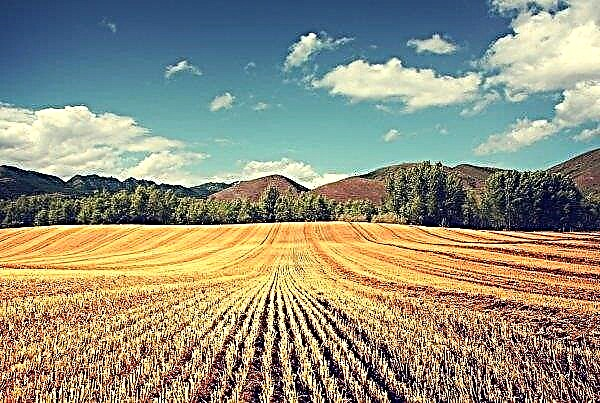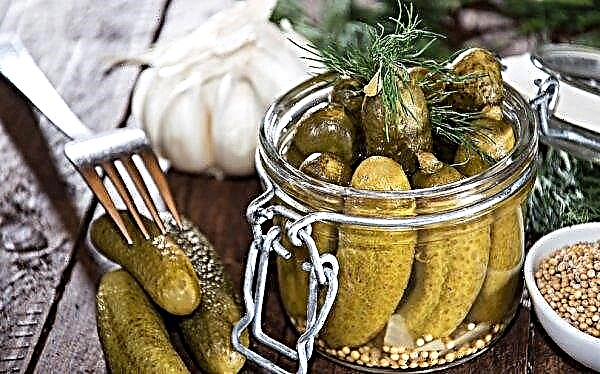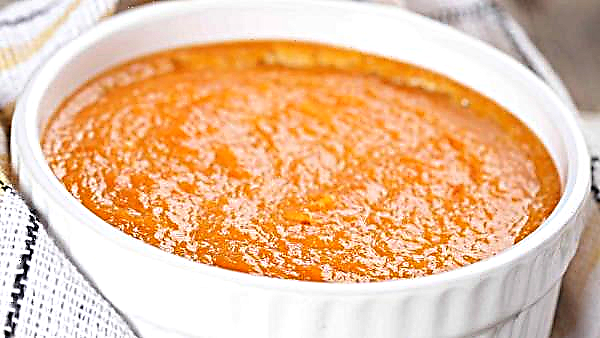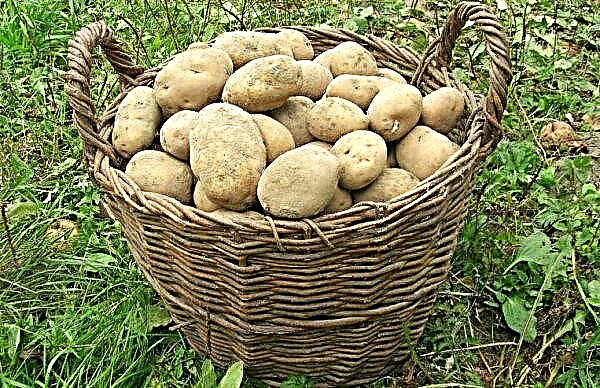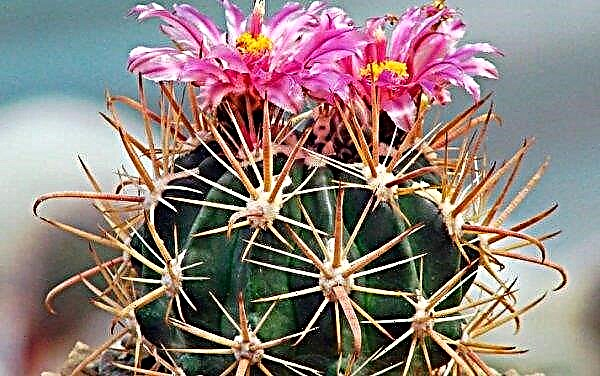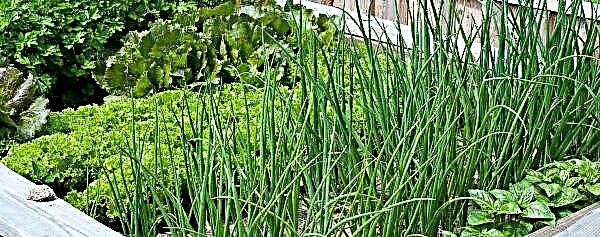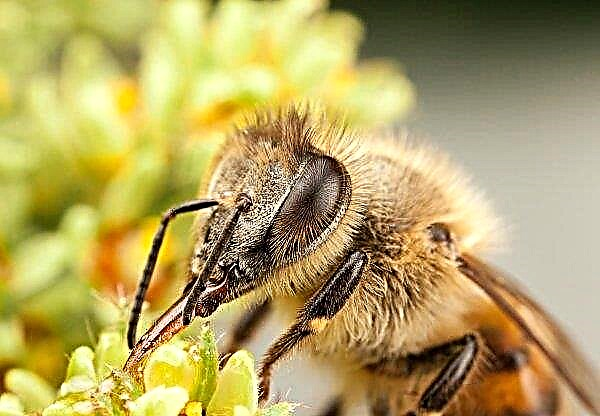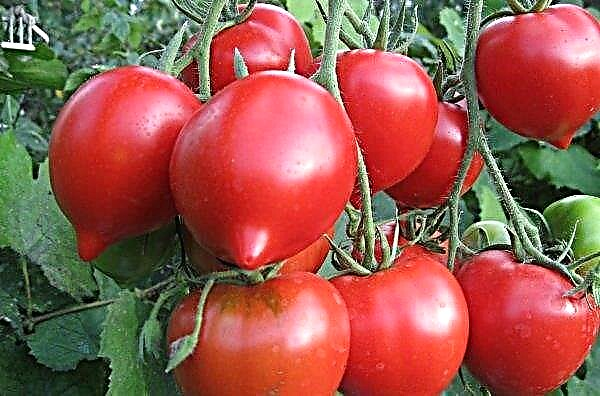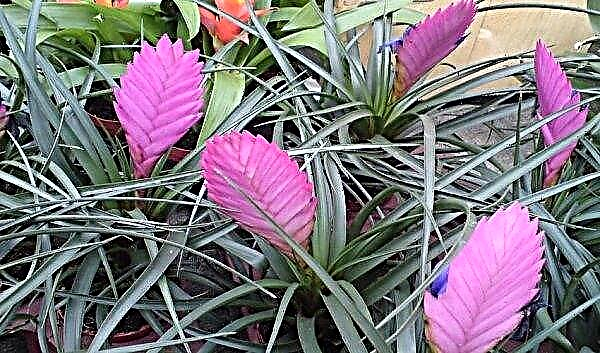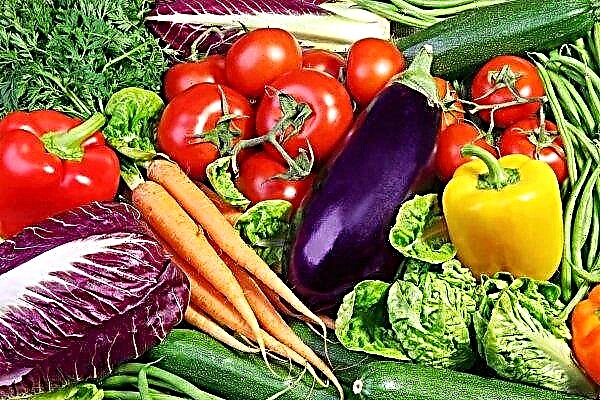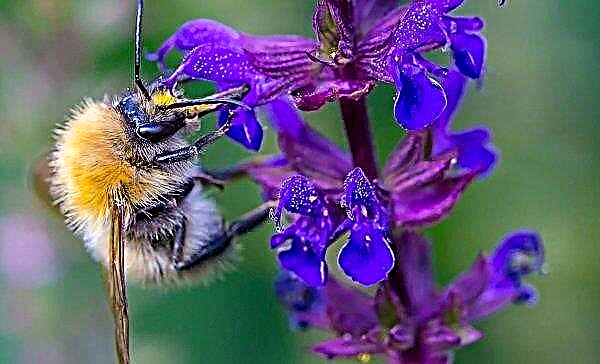White table grapes with nutmeg taste and large grapes always have fans. One of them is the recently introduced Summer Muscat, which has other names - Elena, V-95-22. We will get acquainted with the Muscat summer grape variety, its description and characteristics, how to plant and grow it, collect and store it.
Description and features of the variety
Muscat summer grape variety has early ripening - its clusters can be cut and consumed after 110-120 days from budding. Depending on the region of growth, it is collected from early August (in the south) to mid-September. It is grown mainly in central Russia, in Belarus, Ukraine and Moldova. The variety is quite frost-resistant - up to -23 ° C, although some winegrowers note that it can tolerate lower temperatures, but not for long.
Did you know? Vineyards occupy about 80 thousand km² of land in the world. Of these, 27% are grown for fresh consumption, and 2% goes for drying.
Appearance
Muscat grape varieties have long-growing shrubs, the vine of which can grow up to three meters. The clusters have an average density and average weight of 650 g. Individual brushes reach a kilogram. The berries are large and elongated, a cluster of about 29 × 23 cm in size. When fully ripened, the green grapes become amber. Inside them there are several large seeds. The peel is somewhat dense, but quite edible. The berries, when fully ripened, are sweet, with a distinct muscat taste and smell. Acidity in berries is low, and sugar content can reach 20%.

Advantages and disadvantages
Muscat summer grape variety has its own strengths and weaknesses.
- The advantages of the variety include the following:
- Early ripening.
- Unpretentiousness and resistance to fungal diseases. It is enough to carry out 2 preventive treatments.
- High productivity - fruiting shoots 80%, and fruiting coefficient 1.3–1.8. The vine can carry a lot of stress, but ripening slows down.
- Excellent transportability.
- Berries can hang on a bush for a long time.
- Bisexual flowers of inflorescences do not require pollinating plants.
- Pronounced nutmeg taste in sweet ripened berries.
- Relative frost resistance.
- Good rooting of cuttings.
- Presentation of bunches with amber large berries.
Did you know? The color of grapes depends on the content of coloring polyphenolic pigments. Thickly colored varieties contain anthocyanins, while white varieties are rich in catechin. Most of the antioxidants are in the bones and peel of the berries.
- The disadvantages include the following:
- need to be sheltered for the winter;
- the presence of seeds inside the berries;
- the taste changes and depends on many conditions - climate, load, soil, time of collection;
- may be affected by wasps;
- poor juice yield - table variety;
- the number of brushes is better to normalize.
How to choose quality seedlings when buying
Muscat summer sapling is recommended to buy in nurseries or from bona fide sellers with good reviews. Otherwise, the likelihood of buying a seedling of another variety increases. Purchase must be made during the period of mass sales.
During an external examination, attention should be paid to the following:
- The thickness of the vine in the seedling should not be thinner than 0.5 cm, and better - 0.8-1 cm. Too thick seedlings should also not be taken.
- The seedling should be free of traces of diseases and pests.
- If the container is transparent, then the roots should be carefully examined - they should be well developed, with no signs of rot.
- This year's seedling should have 3 to 5 buds. The kidneys must be alive and not fall off.
- When buying a seedling with bare roots, you must cut off the tip of one root with a pruner. The cut should be light and moist.
- On the roots should not be thickenings and dry patches.
- No need to take seedlings with roots as thin as a cobweb.
- Seedlings must be at least 30 cm long.
- Annual seedlings take root best.
Important! When planted in autumn, seedlings should no longer have leaves, and in spring they should have green leaves of at least 4 pieces.
Landing rules
After buying the Muscat summer grape seedling, it must be planted correctly.
When to plant
You can plant grape seedlings in spring and autumn. Each of the landing options has its advantages and disadvantages. Many people prefer autumn planting - at this time the largest choice of planting material, and it survives well, but may suffer from early frosts if it has not yet been protected. Landing is carried out starting in October and before frosts. Such a seedling is carefully protected from the cold.
Usually a young seedling is covered with plastic bottles with holes for ventilation, and before the onset of frost, it is covered with sawdust, peat, needles or just ground. If the seedling was purchased after the onset of frost, then it is necessary to ensure its safety in the basement until spring planting.
In spring, in the second half of April or early May, annual seedlings are planted that are already numb. When planting, the soil should already warm up to + 10 ° C. Green seedlings have been planted since the end of May, when the threat of the return of cold weather has completely passed. Such plants take root well in the fall and tolerate wintering better.
Where to plant on the site
The place for grapes should be well lit by sunlight and not have drafts. This plant is planted at a distance of 2-3 m from fruit trees and at the same time, they retreat 0.5–0.8 m from the asphalt road. The seedling can be placed on the south side of the buildings, departing from them by 1 m, so that the roots do not destroy the foundation.
A tall variety Muscat summer requires a lot of space for food (3-5 m²), and the height of the trellises will be 2-3 m. You can use an arch, arbor, wall for supports. The soil for the vineyard must be well-permeable and nutritious and in no case swampy.

How to plant
Planting pits for this strong-growing variety are dug at a distance of 2 m from each other in a row and row spacings of 3 m. They begin to dig a few weeks before planting and are made 80 × 80 × 80 cm in size. When digging, the upper fertile layer is folded separately, and then before planting mixed with manure (2-3 buckets) and ash. To them is also added a pound of superphosphate. Then this soil mixture is placed at the bottom of the pit and well watered. Sand is added to the clay soil, and if the soil is sandy, then a hole is dug 25 cm deeper and a layer of crushed stone (10 cm) and clay (15 cm) are poured into the bottom.
Before planting, the seedling is soaked in water, in which root stimulants are recommended to be dissolved. Then, a fertile layer is placed at the bottom of the pit and a seedling “heel” is installed on it at a depth of 0.5 m. Next, the infertile layer is poured, watered and trampled. If necessary, the seedling is covered with earth until growth. Only the planted seedling is watered 2-3 times every week, pouring a pair of buckets of water into the hole. With autumn planting, they are protected from the cold.Important! Groundwater should be no closer than 1.5 m to the surface of the earth.

Care work
Further, summer muscat grape seedlings must be properly looked after.
Watering
Watering the vine bushes begin in the spring. About 2–3 buckets leave for 1 bush. Water for irrigation must be used warm and well-maintained.
The next watering should be carried out during the flowering period of plant crops. A third watering is necessary before wintering, if the autumn rains did not sufficiently moisten the soil. The frequency of watering depends largely on weather conditions. In the heat, you can spend additional hydration of the vineyard.
Did you know? It is recommended to sow parsley under grapes - it protects this crop from some pests.
Top dressing
Large vineyards begin to feed three years after the planting of seedlings.
For this purpose, fertilizers of organic and chemical origin are used:
- mullein;
- chicken droppings;
- peat;
- compost;
- humus;
- potassium sulfate
- ammonium nitrate;
- urea
- superphosphate.
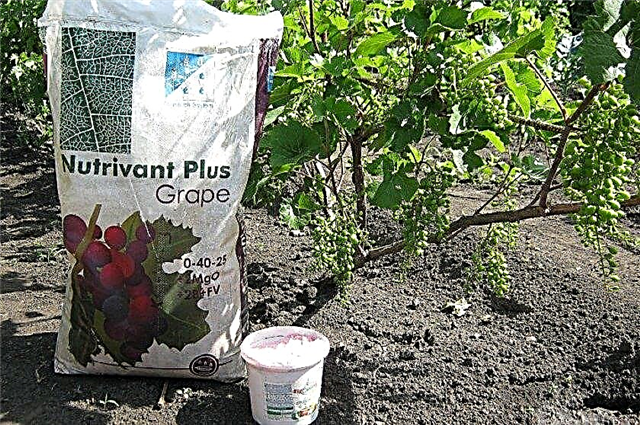
Fruiting bushes should be fed three times during the growing season:
- In the middle of May. Organic fertilizers or ammonium nitrate are used for this purpose.
- When ovary appears. During this period, apply nitrogen-potassium and phosphorus fertilizers.
- The last feeding is carried out in mid-July during the formation of fruits. For this, potassium sulfate and superphosphate are used.
Soil care
After watering, you need to loosen the soil between the rows for better intake of moisture and air to the root system. Such a process is carried out together with weeding - the removal of weed grass. Weeds are very pulling moisture and nutrients, preventing the bush from developing.
To prevent drying out of the soil and to prevent the growth of weeds, the ground around the bushes can be mulched. As mulch, humus, peat, sawdust, mowed grass are used.
Support
The vine is tied to the trellis as it grows. To do this, install supports. Wooden pillars, metal corners or tubes are suitable as such supports. For ease of maintenance, it is necessary that the height of the racks corresponds to the growth of the owner of the grapes. The interval between the supports should be about 3 m. The racks are buried in the ground to a depth of about 40 cm. The diameter of the supports should not be more than 10–11 cm.
To give stability to the structure, connect the upper ends of the support pillars with solid rails or tubes.

Shaping a bush
Muscat summer grape variety shoots up to 3 meters long. But in order to get a good harvest, when forming a bush, no more than 40 eyes should be left. If you do not, there will be more grapes, but the berries will be small.
Pruning
The first three years, pruning bushes done in the spring. This procedure is carried out before budding. More mature bushes are pruned in the fall before shelter for the winter. For the process, use a sharp secateurs, so as not to severely injure the vine. Upon completion of trimming, the places of cuts should be treated with garden varieties to prevent the occurrence of diseases. In the spring, first of all, frozen and diseased areas are removed.
When pruning, it is recommended to trim the upper branches to the 12th kidney, and the lower ones to the 4th. It should be borne in mind that a load of 30–40 eyes is given for each summer Muscat bush.
Cold protection
This variety is quite frost-resistant and can withstand frosts to -19 ... -27 ° C. With long and frosty winters, grapes should be covered in the cold period.
To shelter the bushes, a trench is pulled out nearby and a folded vine is placed. Then place the film, avoiding its contact with the branches. The top is covered with straw, spruce branches and a small layer of soil. In winter, snowfall will also provide protection from the cold.
Shelter is removed after the weather has set with an air temperature above 0 ° C.Important! The sheltering process is carried out before the onset of frost, since in frost the vine loses its elasticity and can be damaged.
Harvesting and storage
Muscat summer grapes ripen by the end of August or early September, depending on climatic conditions. It is very important to choose the time when the grapes have reached optimal taste, and winegrowers are advised not to rush to harvest.
First of all, harvesting should begin in dry weather. In the early morning, you should also not start this process, since the morning dew on the clusters at this time has not yet dried out, and excess moisture leads to a quick spoilage of the crop. It is best to harvest the fruits before dinner, when the berries are the most fragrant.
Clusters should be removed from the bush with well-sharpened scissors so as not to damage the vine. Brush grapes should be collected in a clean container of suitable parameters. For this purpose, special baskets are well suited. They should not be filled completely so as not to crush the lower clusters. Then the bunches of grapes are sorted, the spoiled specimens are rejected for processing. For storage, only ripened, undamaged fruits are selected. Unfit berries (crushed, rotten) are inspected and cut off each brush. Then the bunches are placed in a wooden box with a comb to the top. Fruits should be located a couple of centimeters below the edge of the container for storage.
For storage, only ripened, undamaged fruits are selected. Unfit berries (crushed, rotten) are inspected and cut off each brush. Then the bunches are placed in a wooden box with a comb to the top. Fruits should be located a couple of centimeters below the edge of the container for storage.
After the boxes are moved to a place for storage. They are placed on top of each other, and bars are placed under the lower drawer to ensure normal ventilation.
The optimal storage temperature is from 0 to -1 ° C, and the humidity of the room is 91–95%. Lower humidity causes the berries to dry out, and higher humidity contributes to the appearance of fungal diseases.
The variety has poor juice yield, but sometimes its berries are added to the wine for a nutmeg taste. Summer nutmeg is consumed mainly fresh, but it can be used for making stewed fruit, confiture, and pickling. Its berries can be dried for raisins, after removing the seeds.Did you know? In raisins, there are much more useful substances than in a fresh product. It contains the most optimal ratio between calcium and magnesium.
Fresh grapes well tolerate transportation, but not stored for a long time.
Summer nutmeg is an unpretentious and high-yielding variety of table white grapes with nutmeg taste. Its taste can vary depending on various factors, and when harvesting, you need to choose the moment when they will be the best.


